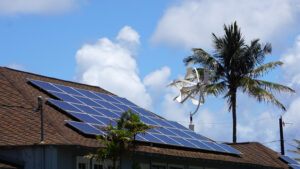A Speedy Transition to Renewables Isn’t Just Cleaner, It’s Cheaper
After upfront costs, investment in renewable energy will begin to pay for itself, making energy cheaper overall for everyone. Image: Adobe
Image: Adobe
Last week, the International Energy Agency put out a new report that turns conventional wisdom regarding the clean energy transition on its head.
It is cheaper for everyone to adopt solar, wind, batteries and other renewables as soon as possible than to go on depending on coal, fossil gas and petroleum. And we’re just talking about energy costs in a vacuum here, not factoring in the climate change damage that fossil fuels do to the planet, which costs billions of dollars a year and will cost ever more as time goes on.
The report’s authors write, that in China in 2023, “more than 95% of new utility-scale solar photovoltaic (PV) installations and new onshore wind capacity had lower generation costs than new coal and natural gas plants. Where electric cars and two- and three-wheelers have higher upfront costs, which is not always the case, they typically result in substantial savings because of lower operating expenses.”
I repeat, solar and wind had lower generation costs. And no wonder, since the cost of solar panels plummeted an astonishing 30% in 2023. And we’re only at the beginning of the transition. Between 2009 and 2019, the price of solar electricity dropped 89%. Think about the last ten years of gasoline prices in the US. The average price of gasoline in 2014 was about $3 per gallon. In 2023 it was $3.52. In real terms, accounting for inflation, the price was probably about flat or down just a wee bit. Fossil fuels are remaining just as expensive as they always were, but renewables are rapidly declining in price. These declines will continue as new technologies are invented and implemented.
Fossil fuels are remaining just as expensive as they always were, but renewables are rapidly declining in price.
Although there are up front costs of building solar and wind farms, these new energy plants will pay for themselves over time, and by the 2040s energy will be much cheaper. The IEA says, “Today, around 50% of total consumer energy expenditure is on oil products, and another 35% is on electricity. In rapid energy transitions these swap places, making the price of electricity the key measure of affordability for most consumers.”
Since the cost of producing electricity by solar is falling so fast, whereas petroleum prices are either stable or slated to rise, if we shift from oil to electricity we obviously are saving a lot of money.
But, we’re going to need some major investments up front to unlock these lower prices. The report says, “As things stand, around USD 3 trillion is invested each year into the energy sector, of which USD 1.9 trillion is in a range of clean energy technologies and infrastructure. By 2035, total investments need to rise to USD 5.3 trillion in the NZE Scenario, with USD 5 trillion going to clean energy.”
The bottom line is the bill you get from your energy utility every month, and your monthly cost for transpiration fuel.The IEA observes, “Our projections highlight that rapid clean energy transitions result in lower consumer bills compared with a trajectory based on today’s policy settings.”
If we stop subsidizing fossil fuels and put the money instead into a Manhattan Project-style full court press for renewables, in 11 years consumers could be paying 20% less for their energy, especially in the developing world.
Your support is crucial…With an uncertain future and a new administration casting doubt on press freedoms, the danger is clear: The truth is at risk.
Now is the time to give. Your tax-deductible support allows us to dig deeper, delivering fearless investigative reporting and analysis that exposes what’s really happening — without compromise.
Stand with our courageous journalists. Donate today to protect a free press, uphold democracy and unearth untold stories.









You need to be a supporter to comment.
There are currently no responses to this article.
Be the first to respond.